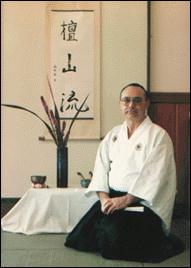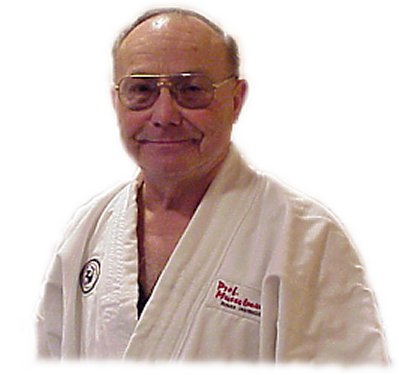

(Reprinted from an article by Nyla & Leeds Davis in the Fall 1992 Issue of the Kiai Echo. Submitted by Steve Balzac.)
Sitting comfortably on his zabuton (pillow) during this interview, Professor Musselman might lead you to believe he was a person used to staying in one place for a long time. Perhaps that is the case now; but before he reached the age of seventeen -- when he finally began jujitsu -- he had moved at least ten times.
If it had been up to his dad, he would have begun jujitsu many years before when a demonstration was held in Sterling City near his hometown. In fact, after the demonstration, his dad signed both of them up twice for a class that could be offered only if there was enough interest. Unfortunately, not everyone was as enthusiastic as Professor Musselman's dad. The class never materialized.
Nine years later Professor Musselman, then living in Chico, was invited to Professor Estes' jujitsu class by Leonard Lambert, a policeman whose beat took him past the theatre where Prof. Musselman worked. Professor Estes' class at that time was comprised of about fifteen students, one of whom was Lamar Fisher -- a Yonkyu. Professor Musselman eventually learned that it was Professor Estes, Leonard Lambert, Grace Lambert, and Luke Estes who had given that demonstration years earlier.
Under Professor Estes' tutelage, Jim Musselman's motivation to learn jujitsu to be "a mean little kid" changed to perfecting the arts themselves. Through gentle persuasion Professor Estes taught him to toughen up mentally and soften compassionately. He learned well the idea of using the least amount of force necessary to counter an attack. In Korea when a drunken GI charged him, he started to do Tomoe Nage before he realized a brick wall was in uke's path behind him. Quickly he adapted the throw to Shidare Fuji Jime, but still the bruise he left on the GI's throat bothered him.
Applying this concept to it's maximum, you can now hear Professor Musselman state: "no finishing art should be taught without a resuscitative technique" -- a far cry from being a "mean little kid."
To Professor Musselman, jujitsu is the practical application of fundamental high school physics -- maximum efficiency with the least amount of energy. He incorporates this definition of jujitsu into all aspects of his life from work to workouts. It's his feeling that the way to learn aspects other than the mechanics of jujitsu techniques it to practice living the martial arts in all facets of your life. This practice he believes will give you focus and excellent concentration.
Obviously, for Professor Musselman, jujitsu is an intellectual pursuit as well as a physical one. He is forever challenged finding solutions for what he calls his students' "Mr. Magillicuty's" (unexpected road blocks that hamper their progress). His dojo patch is a series of spheres that represent all the motions -- oppositions, continuations, deflections, redirections -- found in the martial arts' striking, throwing, falling and submitting techniques.
It is a diagrammatic patch of motion which he sees best represented in throws like Norimi or Dakikubi, where neither Uki nor Tori are referencing the mat: "space training" Professor Musselman calls it. In addition to these intellectualities, he sees all the motions of our entire system in the first seven Yawara techniques!
Professor Musselman believes in the philosophy that all events have a beginning and, necessarily, an ending. Accepting the ending makes the story more enjoyable with no necessity for a particular outcome. A Japanese friend put his concept into perspective for him saying: "There is no value to a yardstick unless it has two ends."
Professor Musselman explains that it would be very unwieldy to measure something with infinity at one end. So too, an important part of a book is its two ends. If you lose an arm in battle, you understand it's alright because you were ready to close the book on that piece of your body anyway. With this attitude the next moment is free of past action. Then a new book can begin.
Even the circularity of jujitsu seems to have a beginning and ending, an ending that merely becomes a beginning again. Such was the discovery of Professor Musselman, Vine Wheelock, and Norman Cole when they began a workout of continuous jujitsu arts and counters with Ogoshi -- and many, many arts and two hour later ended with Ogoshi.
So still sitting comfortably after ninety minutes, you could detect the spark of excitement when Professor Musselman told us that Katate Hazushi Ichi is really an Ogoshi!
We'll leave that one for you to contemplate.
Other Images of Prof. Musselman

Prof. Musselman at the 52nd annual AJJF convention in Boise, ID.
This page maintained by George Arrington.
Back to Home Page.